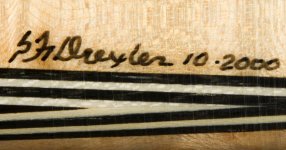Rule #1 in photography - if you want the highest quality images use the highest quality glass.
Fixed focal length lenses produce higher quality images than zoom lenses.
Photographing pool cues I would not use a lens wider than 70mm on a full frame sensor or 50mm on a "crop body" sensor. Look at the image on post #17 - a too wide lens makes the cue look like a banana.
A wide aperture is not relevant (F1.4 or F1.8) as you should be using sufficient light to stop the lens down to about F11.
A pool cue is round (3 dimensional), if want it all to be in focus you have to use a smaller aperture, the tighter the aperture the greater the depth of field.
All lenses have an F-stop sweet spot (check with the manufacturer), generally F8 to F16. This optimum F-stop may not produce the greatest depth of field but it will produce the sharpest image at the point of focus.
The posts in this thread that recommend a certain F-stop and shutter speed are pure speculation. These settings are entirely relevant to the amount of light, distance from the camera to the cue, ISO setting, camera sensor, darkness or lightness of the cue (maple vs. ebony), etc.
Photograph the cue setting the camera on manual (using the lenses best aperture) and bracket different shutter speeds to find the optimum combination for your particular situation.
Macro lenses are not necessary with a good digital camera and lens. The image below was photographed with a Carl Zeiss 135mm lens about 30 inches from the cue. Paul's signature and date is one inch long, the sanding scratches and white spots in the black veneers (Burton Spain blank) are not visible to the naked eye.

